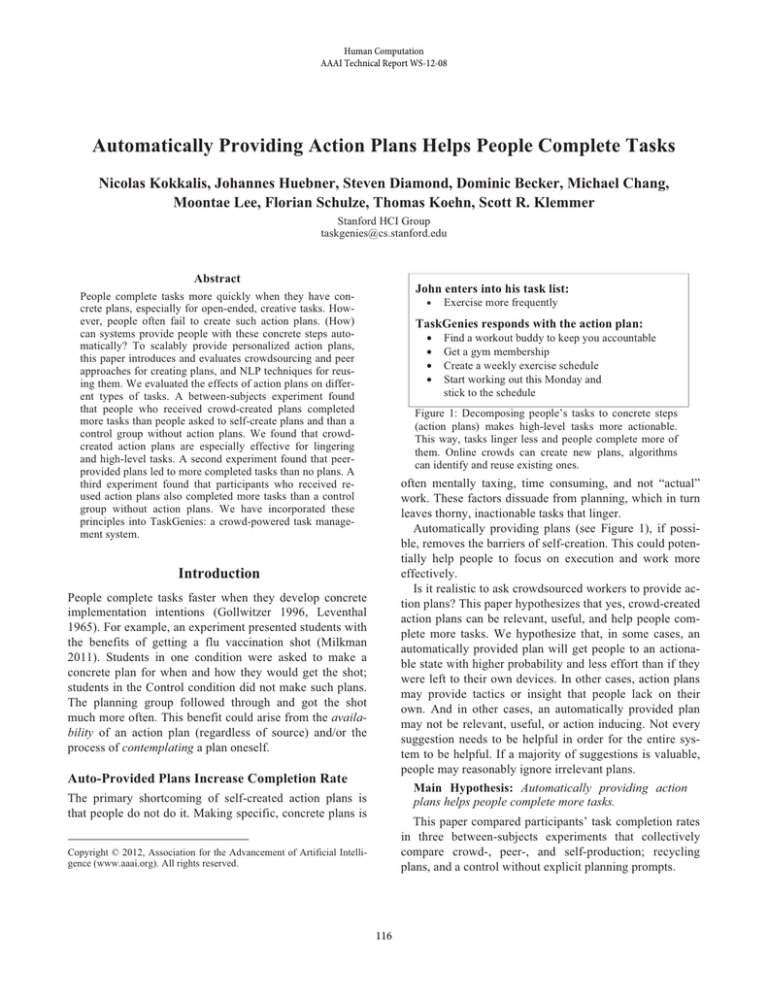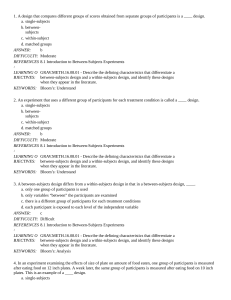
Human Computation
AAAI Technical Report WS-12-08
Automatically Providing Action Plans Helps People Complete Tasks
Nicolas Kokkalis, Johannes Huebner, Steven Diamond, Dominic Becker, Michael Chang,
Moontae Lee, Florian Schulze, Thomas Koehn, Scott R. Klemmer
Stanford HCI Group
taskgenies@cs.stanford.edu
Abstract
John enters into his task list:
People complete tasks more quickly when they have concrete plans, especially for open-ended, creative tasks. However, people often fail to create such action plans. (How)
can systems provide people with these concrete steps automatically? To scalably provide personalized action plans,
this paper introduces and evaluates crowdsourcing and peer
approaches for creating plans, and NLP techniques for reusing them. We evaluated the effects of action plans on different types of tasks. A between-subjects experiment found
that people who received crowd-created plans completed
more tasks than people asked to self-create plans and than a
control group without action plans. We found that crowdcreated action plans are especially effective for lingering
and high-level tasks. A second experiment found that peerprovided plans led to more completed tasks than no plans. A
third experiment found that participants who received reused action plans also completed more tasks than a control
group without action plans. We have incorporated these
principles into TaskGenies: a crowd-powered task management system.
•
Exercise more frequently
TaskGenies responds with the action plan:
•
•
•
•
Find a workout buddy to keep you accountable
Get a gym membership
Create a weekly exercise schedule
Start working out this Monday and
stick to the schedule
Figure 1: Decomposing people’s tasks to concrete steps
(action plans) makes high-level tasks more actionable.
This way, tasks linger less and people complete more of
them. Online crowds can create new plans, algorithms
can identify and reuse existing ones.
often mentally taxing, time consuming, and not “actual”
work. These factors dissuade from planning, which in turn
leaves thorny, inactionable tasks that linger.
Automatically providing plans (see Figure 1), if possible, removes the barriers of self-creation. This could potentially help people to focus on execution and work more
effectively.
Is it realistic to ask crowdsourced workers to provide action plans? This paper hypothesizes that yes, crowd-created
action plans can be relevant, useful, and help people complete more tasks. We hypothesize that, in some cases, an
automatically provided plan will get people to an actionable state with higher probability and less effort than if they
were left to their own devices. In other cases, action plans
may provide tactics or insight that people lack on their
own. And in other cases, an automatically provided plan
may not be relevant, useful, or action inducing. Not every
suggestion needs to be helpful in order for the entire system to be helpful. If a majority of suggestions is valuable,
people may reasonably ignore irrelevant plans.
Introduction
People complete tasks faster when they develop concrete
implementation intentions (Gollwitzer 1996, Leventhal
1965). For example, an experiment presented students with
the benefits of getting a flu vaccination shot (Milkman
2011). Students in one condition were asked to make a
concrete plan for when and how they would get the shot;
students in the Control condition did not make such plans.
The planning group followed through and got the shot
much more often. This benefit could arise from the availability of an action plan (regardless of source) and/or the
process of contemplating a plan oneself.
Auto-Provided Plans Increase Completion Rate
Main Hypothesis: Automatically providing action
plans helps people complete more tasks.
The primary shortcoming of self-created action plans is
that people do not do it. Making specific, concrete plans is
This paper compared participants’ task completion rates
in three between-subjects experiments that collectively
compare crowd-, peer-, and self-production; recycling
plans, and a control without explicit planning prompts.
Copyright © 2012, Association for the Advancement of Artificial Intelligence (www.aaai.org). All rights reserved.
116
against a Control group. This experiment found that Peer
condition participants significantly outperformed the ones
in Control condition. However, on average, participants
contributed fewer plans than the number of plans received.
The third experiment investigated further workload reductions by algorithmically reusing existing action plans.
For a Recycle condition, we designed an algorithm that
selected the action plan based on the similarity of a given
task against a corpus of tasks with existing action plans.
Participant completion rates in the Recycle condition were
found to significantly outperform those of a Control group.
The results of the Peer and Recycle experiments show how
the system can scale for a large number of people.
Figure 2: Participants in the Crowd completed significantly
more tasks than those in the Control and Self conditions.
Error bars indicate 95% CI.
The TaskGenies System
To conduct the experiments, we built TaskGenies, a
crowd-powered task management system, which evolved
with the learnings of this study. There were two primary
technical challenges of this system: first, to design an example-based suggestion interface, that enables crowd workers to produce good action plans; second, to create and
calibrate an NLP algorithm that accurately processes the
often grammatically incorrect task titles. Users manage
their task lists through a mobile or web interface. The system automatically provides users with action plans upon
request or when tasks linger.
Action Plans can be Reused for Multiple People
Creating new action plans for every task seems wasteful
and costly, especially when tasks are similar or repeat. Reusing action plans across people’s similar tasks might be
an effective alternative. But would such recycled action
plans be helpful to people? It is possible that the benefits of
action plans arise from being custom-created for every
task. This paper hypothesizes that tasks can be sufficiently
similar to reuse action plans across people. These recycled
action plans help people complete more tasks.
Reusability Hypothesis: The same action plan can
help multiple people complete similar tasks.
Conclusion
This study compared the average task completion rates
of participants in the Recycle and the Control condition.
The system’s NLP algorithm determined task-similarity.
The contributions of this work are summarized as follows:
Providing action plans helps people complete more
tasks. Action plans help people especially with high-level
and lingering tasks. Action plans are helpful even when
reused across different people with similar tasks.
Crowdsourcing is an effective way to create action
plans, as shown by a method and system we created.
We introduce a technique for successfully scaling this
approach through a combination of peer-produced action
plans and NLP-based reuse.
We recommend that task management systems should
automatically provide action plans to their users and we
demonstrate the first system that accomplishes this.
Evaluation
To test these hypotheses on providing action plans, we
performed three between-subjects experiments.
The first experiment compared task completion rates between a Crowd group in which participants were provided
with action plans from anonymous crowd workers, and a
Control group that was not suggested to create action
plans. To reduce bias of this setup, we also compared it to
a third group of people who were explicitly asked to create
action plans on their own (Self condition). We found that
participants in the Crowd condition completed significantly
more tasks than those in the Control and Self conditions
(see Figure 2). Analyzing completion rates of different
types of tasks we found that providing action plans helps
people more with high-level than small & well defines
tasks. We also found that action plans were particularly
effective with lingering tasks.
To understand whether list users will also be content
creators, a second between-subjects experiment compared
participants who created action plans for each other (Peer)
References
Gollwitzer, P.M. The Psychology of Action: Linking Cognition and
Motivation to Behavior. Guilford Press, New York, USA, 1996.
Leventhal, H., Singer, R. and Jones, S. Effects of fear and specificity of recommendation upon attitudes and behavior. Journal of Personality and Social Psychology 2, 1 (1965), 20-29.
Milkman, K., Beshears, J., Choi, J., Laibson, D., and Madrian, B.
Using implementation intentions prompts to enhance influenza
vaccination rates. In Proc. PNAS 108, 26 (2011), 10415-10420.
117






